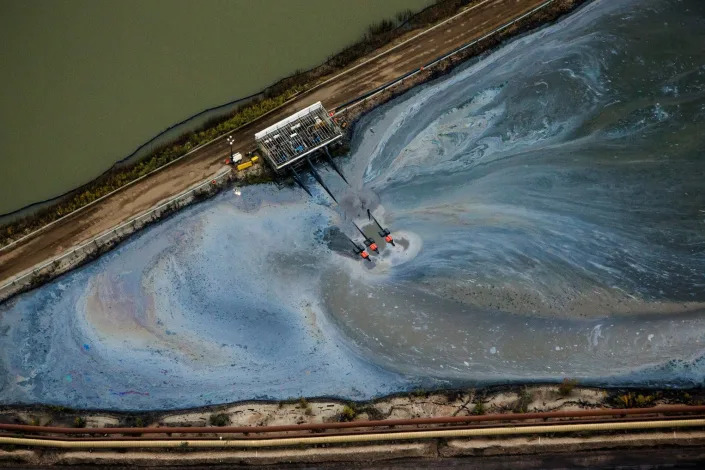Alexander Ryumin via Getty Images
Igor Bonifacic
·Contributing Writer
Thu, January 27, 2022,
A group of Democratic lawmakers led by Senator Elizabeth Warren of Massachuttes has asked six crypto mining companies, including Riot Blockchain, to answer questions about the impact of their operations on the environment and cost of electricity in the US. In separate letters to the chief executives of each firm, the group asks the companies to detail how much electricity they consume, their scaling plans and any agreements they have in place with local utility companies. They have until February 10th to reply.
Lawmakers say they’re concerned about what a dramatic increase in domestic cryptocurrency mining has meant for the environment and consumers. Specifically, they cite a 2021 study from the University of California, Berkeley that estimated crypto mining in upstate New York raised annual electricity bills by approximately $165 million for small businesses and $79 million for consumers, “with little or no local economic benefit.” They also point to the fact that energy consumption related to Bitcoin mining tripled between 2019 and 2021.
“The extraordinarily high energy usage and carbon emissions associated with Bitcoin mining could undermine our hard work to tackle the climate crisis – not to mention the harmful impacts crypto mining has on local environments and electricity prices,” Senator Warren said. “We need more information on the operations of these crypto mining companies to understand the full scope of the consequences for our environment and local communities.”
The group stops short of suggesting regulatory action could be on the horizon for the industry, but clearly the effect of cryptocurrency on other parts of the economy is something lawmakers are thinking about. On January 20th, the House Energy and Commerce Committee held a hearing titled “Cleaning up Cryptocurrency: The Energy Impacts of Blockchains.” What’s more, US lawmakers have taken a more board interest in cryptocurrencies in recent months. That was on display in December when the Senate held a hearing on Stablecoins.

Kevin Dietsch
Aoyon Ashraf
Thu, January 27, 2022
U.S. Sen. Elizabeth Warren (D-Mass.) expanded her inquiry of bitcoin miners’ energy usage and their environmental footprint, sending letters to six more miners on Thursday.
Warren wrote to Riot Blockchain, Marathon Digital Holdings, Stronghold Digital Mining, Bitdeer Group, Bitfury Group and Bit Digital, questioning their “extraordinarily high energy usage.”
In December, Warren, who has made environmental issues a focus of her office, sent a letter to the bitcoin miner Greenidge Generation, expressing her concerns about its high energy usage.
In the new letter, Warren and her colleagues asked each miner to detail its electricity consumption, scaling plans, agreements with electricity companies and impact on energy costs for consumers and small businesses by Feb. 10.
“The extraordinarily high energy usage and carbon emissions associated with Bitcoin mining could undermine our hard work to tackle the climate crisis – not to mention the harmful impacts crypto mining has on local environments and electricity prices,” Warren said in the letter.
The correspondence adds to a list of inquiries by lawmakers globally on the energy consumption of proof-of-work (PoW) mechanisms that reward crypto miners for validating transactions. Most recently, the U.S. held a congressional hearing to discuss the energy consumption related to the PoW. Meanwhile, the European Union's markets regulator called for a ban on the validation system, citing its energy intensity.
"We are encouraged to see that they are interested in learning more about Marathon and the broader bitcoin mining industry, and we welcome the opportunity to participate in the educational process," said Charlie Schumacher, Marathon's director of corporate communications in an email to CoinDesk. "We look forward to having a productive dialogue about the many benefits that we and the rest of our industry have for the United States," he added.
"As a company that is first and foremost tackling a legacy environmental problem left over from the coal industry, any discussion that sheds light on the impact facing Pennsylvanians in relation to their water, land and community is important to us," said a spokesperson for Stronghold Digital, a bitcoin miner who converts coal waste across Pennsylvania into power for mining operations.
Stronghold has received bipartisan support within Pennsylvania and its two facilities, Scrubgrass and Panther Creek, will convert a total of 1.25 million tons of waste coal to alternative energy annually, the company spokesperson said, adding that Stronghold welcomes any dialogue on the environmental issues with Senator Warren and her colleagues.
Meanwhile, another mining company targeted by Warren, Bit Digital, also welcomed talks with the lawmakers, noting that the company has taken a "leadership role" to achieve energy sustainability within the crypto mining sector. "We welcome this sort of high-level dialogue with policymakers in Washington and at all levels of government, and look forward to responding to this inquiry in a timely and informative manner,” said Bryan Bullett, CEO of Bit Digital.
Other three companies didn't immediately respond to request for comments.



